|
|
|
Sort Order |
|
|
|
Items / Page
|
|
|
|
|
|
|
| Srl | Item |
| 1 |
ID:
177882
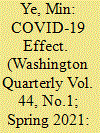

|
|
|
|
|
| Summary/Abstract |
The COVID-19 pandemic has exacerbated geopolitical tensions between the United States and China while restricting policy dialogues, amplifying extreme sentiments, and sidestepping rational observations. The outcomes are extremist and divided narratives, emphasizing China's triumphalism on one hand and inherent weaknesses on the other. Under such narratives, China’s policy voices and actions in combatting the pandemic and economic fallout were under-studied and discounted, with harmful impacts on the US response to the virus, economic recession, and shifting globalization. This paper studies China’s official statements, research reports, and scholarly opinion networks in 2020 and finds that, though there were various policy discussions, the general argument was for expanding China’s globalism during and after the pandemic. Meanwhile, China’s policy actors—national agencies, local governments, and state-owned enterprises (SOEs)—strive to continue globalization and adapt to new realities after COVID-19.
|
|
|
|
|
|
|
|
|
|
|
|
|
|
|
|
| 2 |
ID:
177880


|
|
|
|
|
| Summary/Abstract |
Western democracy is being attacked like never before, but not through overhyped “hybrid warfare.” It is in reality threatened more acutely by hybrid interference, attacks that are often subtle, manipulating for cover the very same liberal democratic values that the attack is designed to subvert. The cornerstones of Western democracy—state restraint, pluralism, free media, and economic openness—provide openings for authoritarian actors to interfere in democratic society through a host of covert, non-military means calibrated to undermine their internal cohesion and accelerate political polarization.
|
|
|
|
|
|
|
|
|
|
|
|
|
|
|
|
| 3 |
ID:
177879
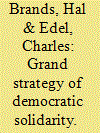

|
|
|
|
|
| Summary/Abstract |
On March 12, 1947, Harry Truman addressed a joint session of Congress with a very specific proposal: emergency aid for Greece and Turkey, which were menaced by a communist insurgency and facing Soviet intimidation, respectively. But Truman, speaking at the dawn of the Cold War, framed the matter far more expansively. Allowing the countries of the world to “work out a way of life free from coercion,” he explained, had been a “fundamental issue in the war with Germany and Japan.” At a time when “nearly every nation must choose between alternative ways of life,” the United States must once again “support free peoples who are resisting attempted subjugation by armed minorities by outside pressures.”
|
|
|
|
|
|
|
|
|
|
|
|
|
|
|
|
| 4 |
ID:
177878


|
|
|
|
|
| Summary/Abstract |
The return of great power rivalry has been the defining feature of the 21st century. Since the beginning of the new millennium, China and Russia have openly defied the United States and upset the stability of the liberal international order. Both China and Russia share physical and material attributes possessed by the United States that are traditionally required for great power status: land mass, a sea portal, a large population, and technology to field and develop a competitive military capability. Most scholars and policymakers agree that China presents the largest challenge to US interests and the US-led liberal international order. Economic and military growth in China has been astounding, surpassing Russian expansion. China’s outward extension is not primarily resource-based as is Russia’s but multidimensional, posing a structural challenge to US military and economic dominance.
|
|
|
|
|
|
|
|
|
|
|
|
|
|
|
|
| 5 |
ID:
177888


|
|
|
|
|
| Summary/Abstract |
Over the past four years, while the Trump administration doubled down on its “America First” foreign policy and Sino-American tensions continued to sharpen, another trend has been equally pertinent: the growing relevance of middle power diplomacy. A loose collection of like-minded, mid-sized players who also are traditional US democratic allies—including Europe (i.e., Germany, France, the United Kingdom, and the EU itself), Canada, Japan, and Australia—have reinforced partnerships with one another and increasingly taken it upon themselves to press forward with multilateral solutions to various regional and global challenges in the absence of leadership from Washington. Underpinning their efforts is a shared concern about the unraveling of international order as the United States abdicated its traditional leadership role under President Trump and China’s assertiveness has grown, especially in the wake of the COVID-19 pandemic.
|
|
|
|
|
|
|
|
|
|
|
|
|
|
|
|
| 6 |
ID:
177887
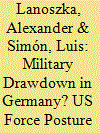

|
|
|
|
|
| Summary/Abstract |
The Biden administration has promised to revitalize a transatlantic alliance that has experienced much strain during Donald Trump’s presidency. Trump’s focus on strategic competition with China, equivocal attitude toward Russia, repeated criticisms of NATO and Germany, and insistence that Europeans pay for their own defense have raised questions about the future of US defense strategy in Europe. Nevertheless, his administration in fact committed additional money and troops to deterring Russia from threatening US allies.1 Amid such confusing signals, one of Trump’s last acts that roiled transatlantic relations was to announce in July 2020 a plan to reduce military personnel stationed in Germany from about 34,500 to 25,000, return some portion of these troops to the United States, regroup some air and command assets in Italy and Belgium, and reinforce the US military’s rotational presence in Poland and the Black Sea region. The announcement of these measures stunned European allies, who had not been previously consulted.
|
|
|
|
|
|
|
|
|
|
|
|
|
|
|
|
| 7 |
ID:
177886


|
|
|
|
|
| Summary/Abstract |
As the United States and the world begins to adjust to a Biden presidency, the North Atlantic Treaty Organization (NATO) once again finds itself at a crossroads. Diplomats and transatlantic supporters on both sides of the Atlantic collectively expelled a sigh of relief last November that a second Trump term—which many feared might spell the end of the 72-year-old alliance—had not come to pass. However, the mood is far from celebratory in either Washington or European capitals because all parties understand that, to steer clear of irrelevancy and remain “fit for purpose,” NATO needs renewal—the question is how?
|
|
|
|
|
|
|
|
|
|
|
|
|
|
|
|
| 8 |
ID:
177883
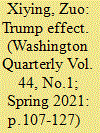

|
|
|
|
|
| Summary/Abstract |
Over the past several decades, the United States adopted a policy of engagement to encourage China to join the US-dominated international system and to shape China’s development direction. Meanwhile, for achieving modernization, China endeavored to integrate into the West-dominated international system. On this point, the United States and China together constructed a grand consensus on “integration-engagement” in bilateral relations.1 However, after the 2008 global financial crisis, the “integration-engagement” framework began to collapse due to two major factors. The first was a change in China’s foreign policy, which was criticized to be more assertive.
|
|
|
|
|
|
|
|
|
|
|
|
|
|
|
|
| 9 |
ID:
177881
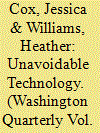

|
|
|
|
|
| Summary/Abstract |
Artificial intelligence (AI) is developing at a rapid pace—both the technology itself and its applications. It is becoming unavoidable in both the civilian and military domains and will soon impact numerous areas of civilian and military life. In July 2020, for example, countries such as Colombia and Russia applied facial recognition technology, a form of artificial intelligence, to combat the coronavirus by detecting whether someone was not wearing a mask or had a high temperature through the use of thermal cameras and sounding an alarm.
|
|
|
|
|
|
|
|
|
|
|
|
|
|
|
|
| 10 |
ID:
177884
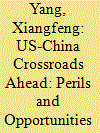

|
|
|
|
|
| Summary/Abstract |
No amount of sugarcoating can downplay the current depth and scope of stress in Sino-US relations. Clashes routinely run the gamut between Beijing’s handling of Xinjiang, Hong Kong, and Taiwan; its industrial policies and trade practices; and its relations with third countries such as Iran. Unfortunately for the People’s Republic of China (PRC), the drastic downturn of its relations with the United States has also coincided with the ongoing spats with a bevy of countries, not least the first flashes of violence in decades on the border with India. Coupled with the fallout from the COVID-19 fiasco, China is facing arguably its worst geostrategic and diplomatic environment since the 1970s.
|
|
|
|
|
|
|
|
|
|
|
|
|
|
|
|
| 11 |
ID:
177885


|
|
|
|
|
| Summary/Abstract |
Despite rising threats and challenges in Northeast Asia, the US commitment to its allies there has become less certain. In part, this is by design. President Trump argued that less categorical signals would encourage US allies to do more, either in their own defense or to support (and finance) forward deployed US forces. Hearing this, Japanese and South Korean (ROK) leaders have been led to consider alternatives to the status quo. They increased defense budgets, a welcome development in Washington, but they also have taken measures that may complicate alliance dynamics, undermine crisis stability, and weaken the broader project of balancing Chinese power. Early in his term, President Biden pledged to improve alliance relations. But confronted with uncertainty, Japan and Korea continue to edge toward offensive systems, including missile forces, which may prove destabilizing in crises. They have also moved away from the roles- and missions-based specialization of military labor that has enhanced alliance efficiencies for decades.
|
|
|
|
|
|
|
|
|
|
|
|
|
|
|
|
|
|
|
|
|